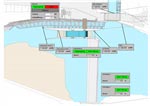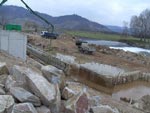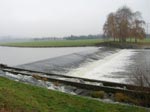The weir at the river Kinzig in Offenburg is also an old dam which was used to divert water into the canal. In the past, the canal was used by raftsmen to bypass the weir. In addition, several former hydropower plants were operated along the canal but only one is still in operation with a design flow of 7.0 m³/s. Due to former river regulations, the current weir serves as a barrage to avoid riverbed deepening (degradation) and a decline of the groundwater level.

Figure 7: Satellite image of the location of the plant in Offenburg
In the course of the construction of the hydropower plant, an additional fish ladder was erected at the weir. The additional pass for fish descending above and below the movable power plant restores the ecological passability for fish and other aquatic organisms.
Up to 7 m³/s of the water is diverted into the canal due to a water rights permit which therefore cannot be used in the new plant. In the course of the implementation of the European Water Framework Directive until 2012 it can be assumed that the water rights permit will be curtailed. This will ensure an increased minimal residual flow in the Kinzig especially in the case of a low water level. The result is a slightly higher water use of the new plant at the weir which in turn will have a positive effect on the annual energy supply.
An additional fish pass for ascending fish has to be provided directly after the sluice of the canal inlet in order to achieve an ecological improvement of the canal.
The weir body has to be renovated and the existing fish ladder has to be reworked. A small inflatable dam system is attached onto the weir to slightly increase the head and to relief the situation in flood water conditions
The construction of the hydropower plant has a positive effect on the environment due to the energy generated from renewable sources and it is possible to supply approx. 550 average households with energy.
Reduction of air pollutants compared with the present energy mix per year:
· carbon dioxide CO2: 1,7890 t
· carbon monoxide CO: 420 kg
· sulphur dioxide SO2: 19,850 kg
· nitrogen dioxides NOx: 4,800 kg
· carbon hydrides: 7,000 kg
· dust: 1,820 kg
Technical data for the hydropower plant:
· double-regulated Kaplan bulb-type turbine with directly coupled permanent magnet-excited synchronous generator
· head: H netto = 2.9 m
· design flow: QA = 20 m³/s
· turbine speed: n = 142.8 1/min
· turbine output: P turb.= 495 kW
· electric power: P electr. = 475 kW
· annual energy production: E = 1,880 MWh
Ecological minimum flow:
· pass for ascending fish: Q asc = 700 ltr/s
· pass for descending fish: Q desc = 400 ltr/s
Water rights permit on the old canal
· canal: Q canal = 7.0 m³/s




